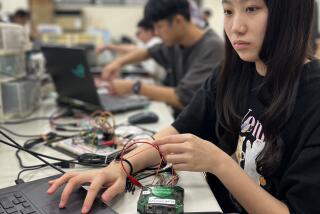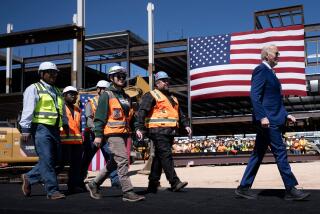Japanese Increase Their Investments in U.S. Chip Plants
SAN FRANCISCO — When Japanese electronics giant Fujitsu announced four years ago that it had agreed to acquire Fairchild Semiconductor--one of the most hallowed names in the U.S. computer chip business--the political uproar was so intense that Fujitsu eventually backed out of the deal. Instead, Fairchild was purchased by National Semiconductor for the bargain price of $120 million.
But reports last week that Japanese electronics giant Matsushita Electric Industrial Corp. is negotiating with National Semi to buy a sophisticated chip factory that had once been part of Fairchild hardly raised an eyebrow. While buying a plant does not raise the same issues of technology transfer and national security as buying an entire company, the lack of controversy in the possible Matsushita-National Semi transaction is also a reflection of how commonplace Japanese investments in U.S. chip facilities have become.
Indeed, despite their preference for keeping cutting-edge manufacturing plants close to home whenever possible, most of the large Japanese chip vendors have made significant commitments to U.S. production facilities. And several have recently announced major expansions.
As in the automobile business, where Japanese firms first made major inroads selling in the American market and then building U.S. factories, Japanese semiconductor companies are motivated by a desire to avoid trade friction and the need to be in close touch with the American market.
Several recent developments, including the possible Matsushita buy, point to two other trends: Second-tier Japanese chip companies are hoping to gain an advantage by moving more aggressively in the United States than their larger counterparts, and Japanese firms are now taking a strong interest in a type of memory chip that U.S. producers have traditionally dominated.
Matsushita, despite its prominence as the world’s largest consumer electronics manufacturer, ranks just sixth among Japanese semiconductor companies. Junko Matsubara, an analyst at the market-research firm Dataquest, said much of the company’s chip production has traditionally been devoted to satisfying the needs of its consumer electronics businesses.
But Matsubara said Matsushita has now committed to increasing the proportion of chips it sells to other firms, and the possible acquisition of the National Semi facility is part of that strategy. Japanese press reports have indicated that Matsushita--in the news recently for its proposed purchase of MCA Inc.--might pay $100 million for the National Semi plant, located in Puyallup, Wash.
National Semi had invested heavily in the Pacific Northwest facility following its 1987 acquisition of Fairchild, spending about $70 million on a new production line for a type of memory chip called static random access memories (SRAMs). But National Semi said last year that it was getting out of the high-performance SRAM business, and decided earlier this year that it would either close or sell the plant, which also makes a different kind of chip called a gate array.
A spokeswoman said National Semi “has been in discussions with a number of domestic and international companies” on the sale of the facility, but declined to say what price the company hoped to get.
Another consumer electronics giant trying to improve its semiconductor capability, Sony, has also bought into the U.S. SRAM business. Earlier this year the company purchased an Advanced Micro Devices factory in San Antonio, paying $55 million and agreeing to transfer production technology to AMD.
Among the big Japanese semiconductor firms, NEC Corp., the world’s leading chip vendor, has the most ambitious U.S. production program. The company has operated a plant in Roseville, near Sacramento, since 1984. But it is now investing $500 million to triple the size of the facility by next spring. Spokeswoman Susan Coleman said: “Our customers are American, and this is the only way to adequately service our customers.”
The NEC plant makes widely used memory chips known as dynamic random access memories (DRAMs), a product that most U.S. manufacturers abandoned in the face of fierce price-cutting by Japanese suppliers. Japanese dumping of DRAMs--selling them below the cost of production--was what ultimately led to the controversial 1986 U.S.-Japan semiconductor trade agreement that effectively fixed the price of DRAMs at a high level.
NEC currently produces DRAMs holding 256 kilobits of information at the Roseville facility, but when the expansion is completed it will also make the latest generation of DRAMs, which can store 4 megabits of data.
Hitachi, also one of the top chip producers, has a fabrication and assembly plant in Irving, Tex., that is being upgraded to produce 4-megabit DRAMs. It is not clear how much Hitachi is investing in the plant, though it is a much smaller factory than NEC’s.
Fujitsu, after being rebuffed on the Fairchild buy, decided to invest $100 million to build a chip fabrication facility in Gresham, Ore. It also produces 1-megabit DRAMs, as well as the customized chips known as application specific integrated circuits.
Toshiba has moved more slowly, not announcing any plans for a major memory-production facility in the United States. Still, the company is spending $45 million to upgrade a Sunnyvale plant that makes custom chips, according to a spokeswoman.
For custom chips, it’s especially important for companies to be near their customers, because customers have a major role in the design process. Indeed, almost all the Japanese companies have had at least design facilities in the United States since the early 1980s.
In contrast to Toshiba, two smaller Japanese chip firms, Oki and Mitsubishi, have committed to building major memory production facilities in the United States.
JAPANESE-OWNED CHIP PLANTS IN U.S. as of June, 1990
Year into service Company City or aqcuired Fujitsu Gresham, Ore.* 1987 San Diego 1979 Hitachi Irving, Tex.* 1978 Mitsubishi Durham, N.C. 1983 NEC Roseville.* 1978 Oki Tualatin, Ore. 1990 Rohm (Exar) Sunnyvale 1981 Exel San Jose 1983 Sony San Antonio, Tex. 1990 Stanley London, Ohio 1987 TDK (Silicon Systems) santa cruz. 1989 Tustin 1989 Toshiba** Sunnyvale 1980
*expansion under way **expansion planned, site to be determined Source: DATAQUEST






